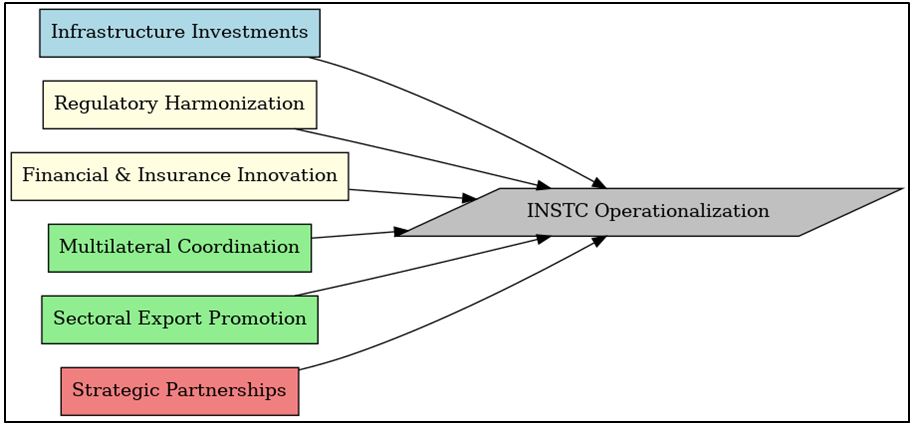Enhancing India's Economic Integration with Eurasia: The Strategic Role and Evolving Dynamics of the International North–South Transport Corridor (INSTC)
DOI:
https://doi.org/10.5281/zenodo.15034719Keywords:
INSTC, international trade, energy security, gravity model, export potential, eurasian connectivity, geopolitical dynamicsAbstract
India’s ambition to become a global economic powerhouse is increasingly linked to its ability to diversify export routes and secure a stable supply of energy resources. The International North–South Transport Corridor (INSTC) has emerged as a pivotal multimodal network that connects India to Russia, Europe, and Central Asia via Iran. By offering a route that is up to 40 percent shorter and 30 percent cheaper than traditional maritime channels such as the Suez Canal, the INSTC represents both an economic and strategic alternative amid rising geopolitical uncertainties and logistical bottlenecks. This paper synthesizes insights from extended gravity model analyses, policy briefs, and empirical studies to examine the evolution, operational challenges, and future prospects of the INSTC. Data from recent sources indicate that while India’s exports to INSTC member countries stood at approximately US$20 billion in 2022, there exists a latent potential estimated at nearly US$180 billion if infrastructural and regulatory challenges are resolved. The analysis reveals that the corridor not only reduces transportation costs and transit times but also fosters network spill overs through the creation of regional logistics hubs. Moreover, in a geopolitical landscape marked by sanctions on traditional trade routes and emerging alternatives such as China’s Belt and Road Initiative (BRI), the INSTC offers a counterbalance that enhances India’s strategic autonomy. Policy recommendations include accelerating intermodal infrastructure investments, harmonizing customs and regulatory procedures, and devising innovative financial mechanisms to overcome banking and insurance challenges. Overall, the INSTC is positioned as a transformative enabler that can reshape regional integration, boost export competitiveness, and reinforce India’s energy security.
Downloads
References
Azmi, S. N., Khan, K. H., & Koch, H. (2024). Assessing the effect of INSTC on India’s trade with Eurasia: an application of gravity model. Cogent Economics & Finance, 12(1). https://doi.org/10.1080/23322039.2024.2313899.
Chatterjee, S. (2018). International north south transport corridor (INSTC) connecting India central – Asia. International Journal of Research in Social Sciences, 8(4), 601–603. Available at: http://www.ijmra.us.
Ghiasi, F., Muniraju, Y., & Ghiasi, F. (2019). The international north –south transport corridor: Challenges and prospective. International Journal of Business and Management Invention, 8(04), 37–43.
Gupta, P. K. (2022). Revitalization of INSTC and prospects of the greater Eurasian connectivity. Vivekananda International Foundation.
INSTC (International North South Transport Corridor). (2021). INSTC (International North South Transport Corridor) connecting Eurasia and India. EURAS Journal of Social Sciences, 1(1), 53–76.
Johny, S. (2023, May 20). North-south transport corridor | Connecting continents. The Hindu. https://www.thehindu.com/news/international/north-south-transport-corridor-connecting-continents/article66875206.ece.
Khan, S. (2021). INSTC (International North South Transport Corridor) connecting Eurasia and India. EURAS Journal of Social Sciences, 1(1), 43–60.
Krishnankutty, P., & Krishnankutty, P. (2024, April 4). A dormant transport corridor between India, Russia, Iran is active 20 years later. Here’s why. The Print. https://theprint.in/diplomacy/a-dormant-transport-corridor-between-india-russia-iran-is-active-20-years-later-heres-why/2024254/.
Mann, P., & Centre for Air Power Studies (CaPS). (2018). International north south transport corridor a game changer for India?. Defence and Diplomacy Journal, 8(1), 1–14.
MP-IDSA. (2023, December 28). International north-south transport corridor: Re-energising India’s Gateway to Eurasia - MP-IDSA. https://www.idsa.in/publisher/issuebrief/international-north-south-transport-corridor-re-energising-indias-gateway-to-eurasia/.
Pal, L. C. (2024). The international north-south transport corridor (INSTC) and India: potential and impediments. Brazilian Journal of Political Economy, 44(3). https://doi.org/10.1590/0101-31572024-3556.
Peri, D. (2025, February 1). Vessel, container traffic increased via Chabahar Port and INSTC in FY24: Economic Survey. The Hindu. https://www.thehindu.com/business/budget/vessel-container-traffic-increased-via-chabahar-port-and-instc-in-fy24-economic-survey/article69164241.ece.
Rebuilding interconnections: Russia, India and the international North-South transport corridor. (2020). AsiaGlobal Online. https://hal.science/hal-02980041v1.
Sharma, N. (2021, April 1). Energy security of India: Role of international north-south transport corridor. https://www.ejsss.net.in/article_html.php?did=9673&issueno=0.
Taneja, N., Joshi, S., Dua, S., & Siddiqui, A. (2024). Why INSTC is more important than ever for India. https://icrier.org/pdf/Policy_Brief_24.pdf.
Tashijan, Y. (2024, November 17). The future of regional corridors in the Middle East and India’s role. https://www.orfonline.org/expert-speak/the-future-of-regional-corridors-in-the-middle-east-and-india-s-role.

Published
How to Cite
Issue
Section
License
Copyright (c) 2025 Dr. Amaan Anjum

This work is licensed under a Creative Commons Attribution 4.0 International License.
Research Articles in 'Management Journal for Advanced Research' are Open Access articles published under the Creative Commons CC BY License Creative Commons Attribution 4.0 International License http://creativecommons.org/licenses/by/4.0/. This license allows you to share – copy and redistribute the material in any medium or format. Adapt – remix, transform, and build upon the material for any purpose, even commercially.









